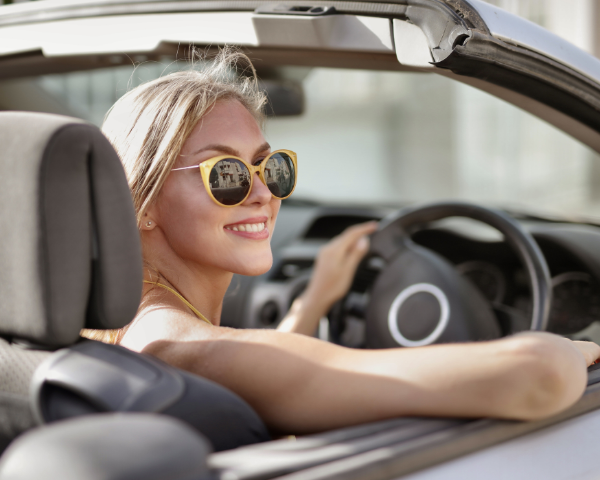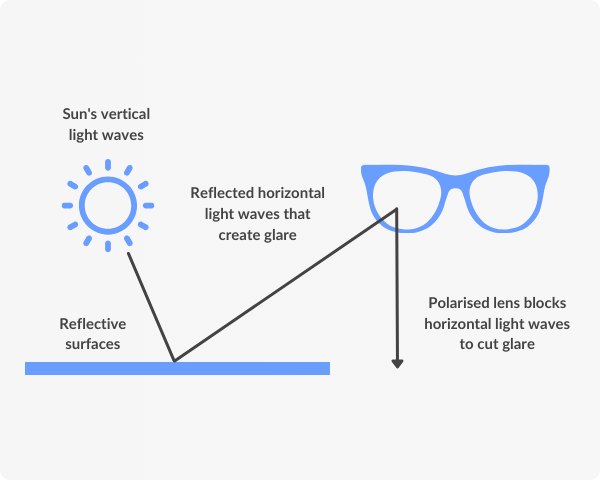What You Need to Know About Driving With Polarised Sunglasses

Reviewed by
Maria Horan
Are you tired of squinting into the sun while driving? It’s time to consider the game-changing benefits of polarised sunglasses.
In this guide, we’ll delve into how polarised sunglasses can revolutionise your driving experience and all the information that you need to know while driving in them.
What are polarised sunglasses?
Polarised lenses, found in polarised sunglasses, have a unique chemical coating to act as a filter. This filter selectively blocks horizontal light waves, reducing glare from surfaces like water, roads, or car hoods.
By eliminating reflected light, polarised sunglasses improve visual clarity, depth perception and colour contrast, enhancing overall comfort for wearers.

Are polarised sunglasses good for driving?
Polarised sunglasses are great for outdoor activities, including driving.
This is because they help to reduce glare from surfaces like roads and water, making it easier to see clearly and stay focused on the road ahead.
With less glare, drivers can enjoy enhanced visibility, better contrast and reduced eye strain, leading to a safer and more comfortable driving experience.
However, it’s important to note that while polarised sunglasses offer many benefits for driving, these sunglasses may not be suitable for all driving conditions.
DID YOU KNOW?
Polarised sunglasses can improve daytime driving safety by 15%. (Zikos et al., 2009)
Pros and cons of driving with polarised sunglasses
Driving can be more enjoyable and safer with the correct eyewear. Here are a few pros of wearing polarised sunglasses while behind the wheel.
Enhanced visibility
Polarised sunglasses offer enhanced visibility in bright sunlight, and greatly reduce glare created by the low winter sun.
Improved clarity
They also improve clarity by filtering scattered light, which can help in the identification of obstacles and pedestrians, and can therefore enhance reaction times and safety while driving.
Reduced eye strain
Additionally, they provide a comfortable driving experience by reducing eye strain, which helps to reduce fatigue especially during long journeys or in challenging weather.

While polarised sunglasses offer numerous benefits, it’s essential to acknowledge potential drawbacks.
Hindered visibility of screens
The first notable downside of polarised sunglasses while driving is the hindered visibility of screens within your car such as your dashboard or GPS.
This occurs due to the way the polarised lenses filter out light.
To avoid this issue, it’s advisable to opt for the best sunglasses that offer optimal clarity and minimal interference with screen visibility.
Polarised sunglasses also don’t reduce glare from things like headlights or sunlight which shines from above while on the road.
Factors to consider when choosing the right polarised sunglasses for driving
As mentioned previously, polarised sunglasses are an invaluable tool for minimising glare and ensuring clearer vision when driving.
However, when purchasing polarised sunglasses, it’s also important to check if the specific pair you’re interested in will protect your eyes from harmful UV rays or if you need to make a change to ensure proper protection.

As well as UV protection, consider factors like frame design, lens colour and fit to ensure optimal comfort and performance.
Look for frames that offer sufficient coverage to shield your eyes, and choose lens colours suited to your typical driving environment.
Most importantly, prioritise driving sunglasses that meet your needs for clear vision and comfort on the road.
Drive safe with polarised sunglasses
Polarised sunglasses are perfect for daytime driving as they effectively block glare and improve visibility on the road.
Although sunglasses can reduce the irritation and glare, it’s important to remember that polarised sunglasses should not be worn at night as they can make it harder to see objects, potentially increasing the risk of accidents.
It’s safer to opt for clear, non-polarised and anti-reflective lenses when driving at night to ensure optimal visibility and safety on the road.
If you’ve got questions about polarised lenses, or anything related to eyecare and eyewear, you can speak to one of our certified opticians via the link at the top of the page.
References
Zikos, G. A., Nason, R. J., Robilotto, J., & Selenow, A. (2009), Contrast Sensitivity and Reaction Times with Polarized and Tinted Lenses in a Driving Environment. Investigative Ophthalmology & Visual Science, 50(13), pp.5331-5331.






































